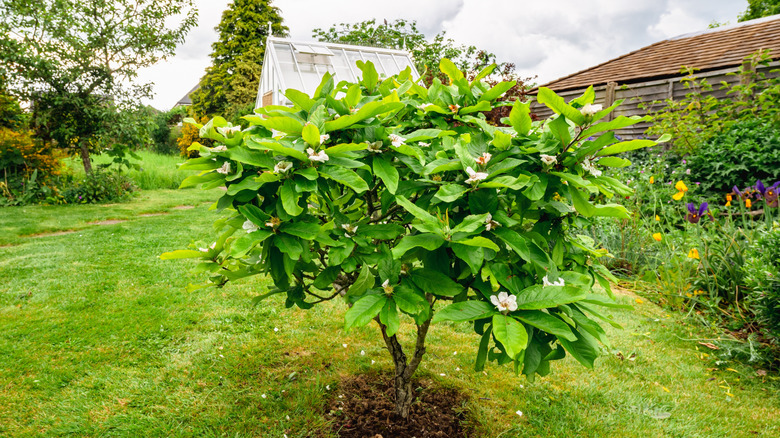Why A Dwarf Mulberry Tree Can Be Deceiving To Gardeners
When you think of a dwarf fruit tree, you probably envision a fairly diminutive plant that's not likely to get any taller than around 6 feet and can easily grow in a large container. Such is the case with many dwarf varieties, making them much easier to manage and harvest. But you might be surprised if you expect a dwarf mulberry tree (Morus spp.) to be the same. Although they're labeled as dwarf trees — like the 'Dwarf Everbearing' mulberry, which grows in USDA hardiness zones 4 through 10 – these can reach lofty heights of 10 to 15 feet if planted in the ground.
While it's possible to grow one of these in a container, you're going to need a large one that's at least 20 inches in diameter. This tree can live in a pot for 10 to 15 years, but you'll have to repot it into a larger container every few years due to its aggressive growth and massive root system. This is also something you should be aware of if you're going to plant a dwarf mulberry tree in the ground. The roots are shallow and aggressive, and they can cause problems if the tree is planted close to infrastructure, such as paths, buildings, and underground sewage and water pipes. You should also be aware that some mulberry trees are illegal to grow in various jurisdictions, although this is not usually the case with the dwarf varieties that are hybrids of the black mulberry.
Other disadvantages of growing dwarf mulberry trees
A dwarf mulberry tree grown in a container will be somewhat limited in height and can be maintained at around 6 feet tall with just minimal pruning. However, if you're going to plant it in the ground, you'll have to prune it every year. This should be done after the tree has lost its leaves and is dormant in winter. When pruning, make sure you wear gloves because the branches contain a milky sap that can cause skin irritation in some people.
Just like normal mulberry trees, the fruits on the dwarf mulberry will cause staining if they end up on paths, verandas, driveways, or other hardscaping in your yard. That's one of the major reasons that this is one plant you shouldn't grow right next to your house. Also note that if the fallen fruits are accidentally stepped on, this staining could be carried indoors if you're not careful. This can be particularly troublesome if you have children or pets, so you might want to think twice before planting this tree in your backyard at all.
Finally, while a dwarf mulberry tree will certainly produce lots of edible fruits, these generally come all at once, and you may find there are more fruits than you can consume. While this can be a challenge, they do freeze quite well and can then be used in cooking or smoothies, or you can make mulberry jam with the fresh fruits.

